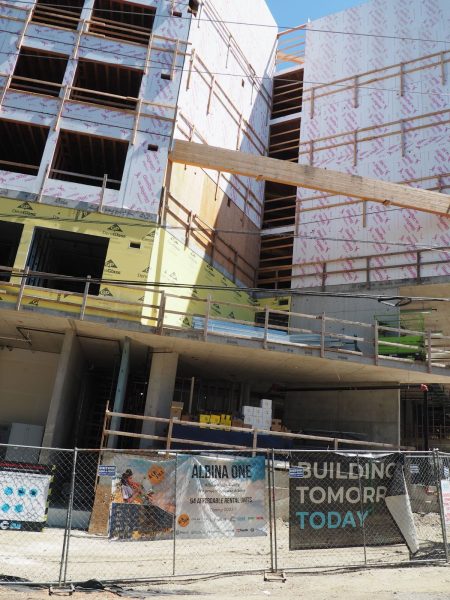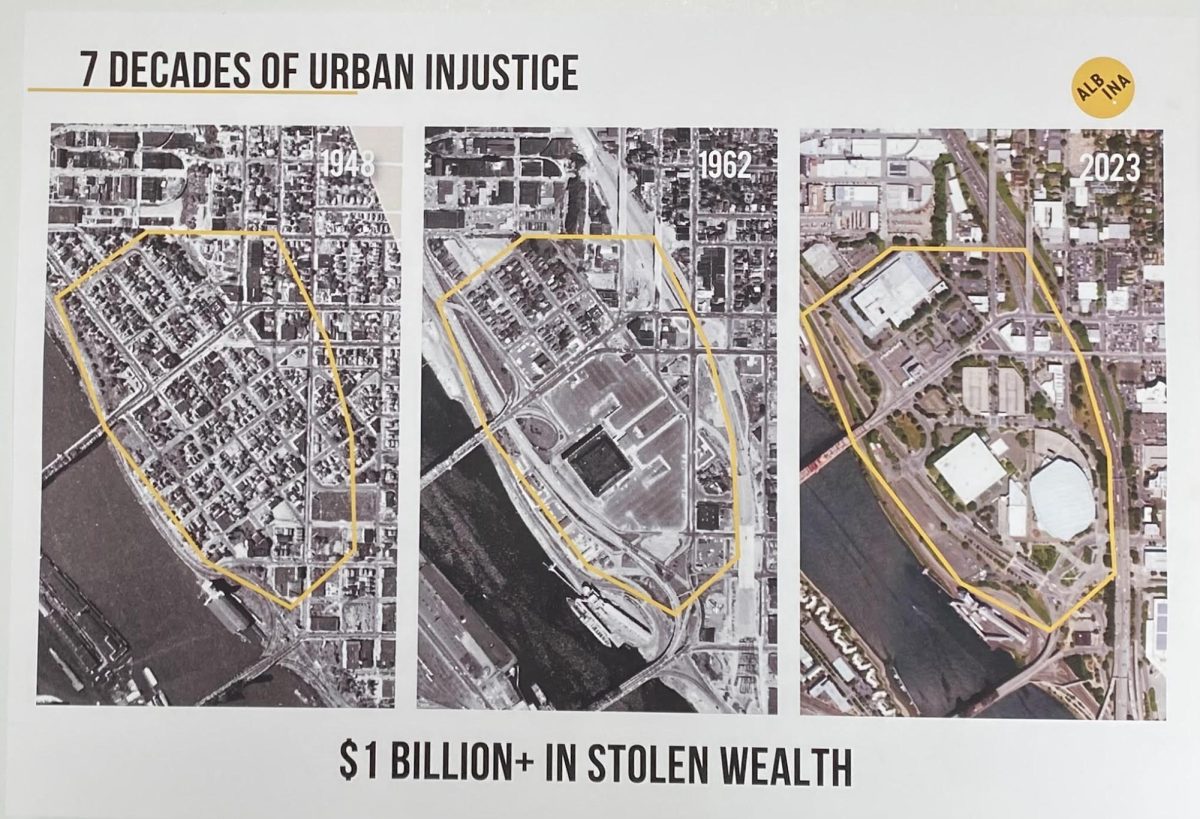“What if we flipped the process on its head and started with what the community wants and needs, and then use that community input to shape our plan for the district?” says JT Flowers, the Director of Government Affairs and Communications for Albina Vision Trust (AVT).
In 2020, Albina Vision Trust, a local non-profit, began planning a remimaged Albina; their mission was to restore the damage done by decades of urban injustice to the historically Black Portland neighborhood. AVT imagines a new future that reflects the communities who haven’t given up on the neighborhood after decades.
Albina once held a flourishing Black neighborhood on the eastside of Portland’s Willamette River. It was home to the majority of Portland’s Black residents and was one of the few places Black people were allowed to live due to racist exclusionary policies. The neighborhood has since been torn apart by urban renewal policies and government projects such as the building of Interstate 5 (I-5) and the Veterans Memorial Coliseum.
“We really like to draw the long standing historic thread when we talk about the formation of AVT,” says Flowers while he holds up a worn white poster board with black and white photos taped to it. The poster shows three drone shots of Albina that AVT often uses to visualize the immense damage done to Albina. Above the photos, the poster reads, “Seven decades of urban injustice.”
The first image shows the Albina neighborhood in 1948. Small walkable blocks filled with single family homes, greenery, beloved Black-owned businesses, successful education facilities and a thriving music scene created a neighborhood that so many remember fondly.
World War II brought Black workers from all over the U.S. to Portland to work in the Henry Kaiser Shipyards; the city of Vanport was built to accommodate the large number of workers who needed housing. Vanport, built as temporary housing in a floodplain off the Columbia River, flooded in May 1948, leaving 18,000 of its residents homeless. Albina was left as the only place in Portland where people of color were allowed to live. It was then that Albina became home to 80% of Portland’s Black population.

The second image taped to AVT’s poster board showcases the construction of I-5 in 1962. The Albina neighborhood was first harmed in 1950 when the Oregon State Highway Department extended Highway 99W, cutting off Albina from the Willamette River. Interstate 5 was then built through a section of lower Albina in 1962, tearing down Black-owned homes as it went.
Following the highway construction was the continued demolition of areas in Albina to allow for the creation of the megastructures that take up much of lower Albina today, including the Veterans Memorial Coliseum, the Portland Public Schools (PPS) administrative headquarters and a section of I-5.
Starting in 2020, AVT leaders worked with members of the community for three years to create the Community Investment Plan, a plan made to put Portlanders in charge of the future vision of Albina. They are currently working towards the largest restorative redevelopment effort in America, with a plan to convert a 94-acre area into an affordable, pedestrian-centered space. They are also focused on promoting inclusivity and wealth building opportunities for a diverse community.
A significant step forward in AVT’s plan came in 2021, when AVT successfully secured the right of first offer and the right of first refusal on the 10-and-a-half-acre PPS administrative headquarters building located in the lower Albina neighborhood. This past February, the PPS board committed to a plan to sell the building within a year, using AVT’s help to find a new location.
The resolution document passed by the PPS board on February 20, 2024 reads, “Institutions — especially Portland Public Schools — have a moment, an opportunity to lead, not with race-neutral plans, but with an anti-racist agenda that begins and amplifies an intergenerational healing process among students, their families, and our community.”
AVT plans to turn the huge PPS campus into an entire neighborhood instead of the parking lots, meeting rooms and office spaces that the 10.5 acres currently holds. Out of the 1,000 units planned to be built on the property, 500 of them will be affordable housing. This redevelopment project is one step closer to reality due to a $25 million allocation approved by the Oregon legislature in February.
This neighborhood-centered plan follows AVT’s inaugural affordable housing development, Albina One, a 94-unit development that has been under construction since August 2023. All housing in Albina One, as well as in future buildings constructed by AVT, will be part of the Portland Housing Bureau’s N/NE preference policy which guarantees that residents who have been harmfully impacted by urban renewal projects in the past will get priority to the new housing at these sites.
A common concern when talking about building back the Albina neighborhood, is how poor air quality around I-5 will affect those living so close to the freeway. Flowers recognizes that AVT, “Can’t just ask thousands of people who have been pushed out of the district to come back and call this place home again if it is going to adversely affect their lives in the most basic ways.”
AVT understands the unjust challenges, such as reduced life expectancy and increased medical issues, that many Albina residents have experienced from living so close to I-5. Because of this, AVT strives to achieve climate justice for the Albina community moving forward. They are committed to using sustainable construction materials and plan to install a district-wide geothermal heat pump system, as well as a microgrid connected to a battery operated system powered by solar panels. These will allow the neighborhood to run completely on clean energy and make AVT the “largest climate positive development … in the country.”
Another critical piece of the non-profit’s vision is reconnecting the neighborhood that was destroyed by the construction of I-5. AVT is partnering with the Oregon Department of Transportation (ODOT) to create an eight-acre highway cover that will house elements of the re-envisioned neighborhood, including buildings up to four stories high.
In March 2024, the federal government gave ODOT a $450 million grant for this project. They also gave an additional $38 million to the Portland Bureau of Transportation (PBOT) to make Broadway St. safer and more bike and pedestrian friendly in order to support the residents of the re-envisioned community.
Flowers works alongside a crew of staff, a board of directors and a leadership council at AVT. Other core members of the AVT team include Executive Director Winta Yohannes, Board of Directors Chair Michael Alexander and board member Rukaiyah Adams.
After decades of harm, lower Albina will be thoughtfully recreated by AVT’s team and the Portland community. Flowers explains, “Our primary goal is to reroute historically displaced populations and what has the potential to be one of the most beautiful areas of our city.”





























